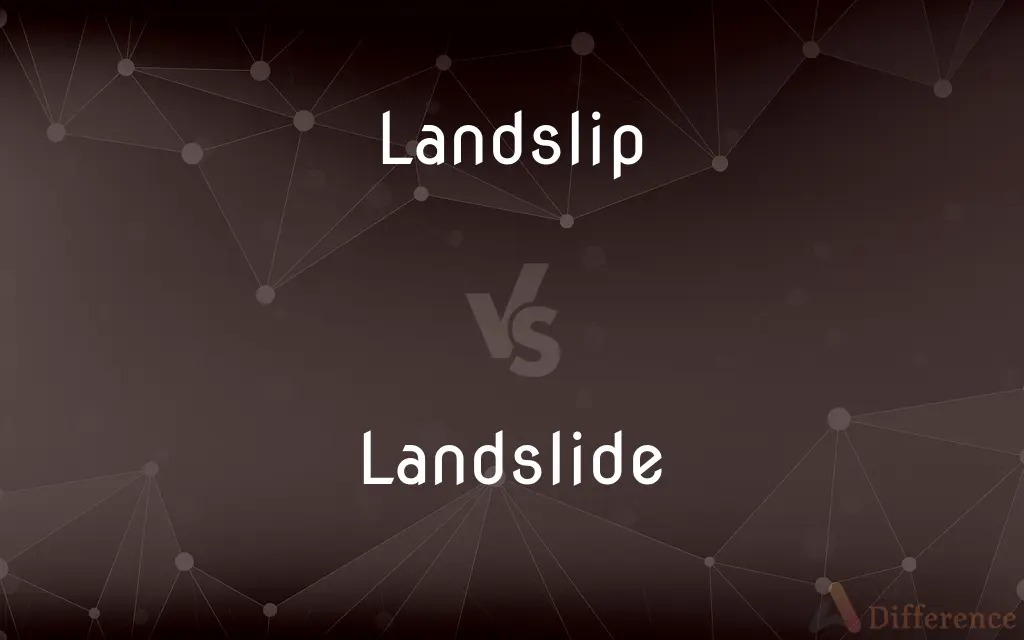Landslip vs. Landslide — What's the Difference?
By Tayyaba Rehman & Fiza Rafique — Updated on March 11, 2024
Landslip and landslide both refer to the movement of earth materials down a slope, but landslip often implies a smaller, more localized event, while landslide is used for larger-scale movements.

Difference Between Landslip and Landslide
Table of Contents
ADVERTISEMENT
Key Differences
A landslip, also known as a slip, typically refers to the downward movement of rock, earth, or debris along a slope. It is often used to describe smaller, more localized events that may affect a specific area of a hillside or embankment, causing disruption but usually on a scale that is less catastrophic than larger landslides. On the other hand, a landslide is a term that encompasses a wide range of ground movements, such as rockfalls, deep failure of slopes, and shallow debris flows. Landslides can occur on a much larger scale, affecting extensive areas of land and potentially leading to significant damage to property and loss of life.
Landslips can be triggered by various factors, including saturation from rainfall, earthquakes, or human activities that destabilize the slope. The term landslide implies a broader and often more severe movement of earth materials, which can be triggered by similar factors as landslips but with effects that are more far-reaching.
Both landslip and landslide involve the displacement of soil, rock, and debris under the force of gravity. However, the distinction often lies in the scale and impact of the event. Landslips might cause localized problems, such as blocking a road or damaging a small section of a hillside, while landslides can result in the destruction of homes, infrastructure, and alteration of the landscape.
The terminology used to describe these events can vary by region and context. In some areas, landslip and landslide may be used interchangeably, while in others, the terms are carefully distinguished based on the size and severity of the event.
Prevention and mitigation of both landslips and landslides involve understanding the local geology, proper land management practices, and sometimes engineering solutions to stabilize slopes or divert the flow of potential debris. Awareness and preparedness are key in areas prone to such geological hazards, with measures including early warning systems and land-use planning designed to minimize risk.
ADVERTISEMENT
While both landslips and landslides represent significant natural processes that can pose risks to humans and infrastructure, the understanding and management of these events are crucial for reducing their impact on communities and the environment.
Comparison Chart
Scale
Smaller, localized
Larger, extensive
Impact
Less catastrophic, may cause localized damage
Potentially severe, with extensive damage
Trigger Factors
Rainfall, earthquakes, human activity
Rainfall, earthquakes, human activity
Area of Effect
Specific area of a hillside or embankment
Extensive areas of land
Mitigation Measures
Land management, engineering solutions
Land management, engineering solutions, early warning systems
Compare with Definitions
Landslip
May cause disruption but usually less catastrophic.
A landslip disrupted the hiking trail, requiring repairs.
Landslide
Triggered by similar factors as landslips but more extensive.
Heavy rainfall induced a massive landslide affecting the entire valley.
Landslip
Often smaller in scale than landslides.
The construction project was delayed by a minor landslip.
Landslide
Requires comprehensive mitigation measures.
The government implemented an early warning system to prevent future landslide disasters.
Landslip
Can be caused by various factors including human activities.
Excavation work led to a landslip affecting the hillside.
Landslide
A broad term for large-scale earth movements.
The village was evacuated due to a threat of a landslide.
Landslip
Specific to certain areas, affecting localized regions.
The landslip damaged a portion of the railway line.
Landslide
Can result in significant damage and loss of life.
The landslide destroyed several homes and blocked the highway.
Landslip
A localized movement of earth material down a slope.
The recent rains triggered a landslip that blocked the rural road.
Landslide
Involves a wide range of ground movements.
The geological survey reported a landslide that included rockfalls and debris flows.
Landslip
See landslide.
Landslide
The term landslide or, less frequently, landslip, refers to several forms of mass wasting that may include a wide range of ground movements, such as rockfalls, deep-seated slope failures, mudflows, and debris flows. Landslides occur in a variety of environments, characterized by either steep or gentle slope gradients, from mountain ranges to coastal cliffs or even underwater, in which case they are called submarine landslides.
Landslip
The sliding of a mass of land down a slope or cliff; a landslide
Landslide
The downward sliding of a relatively dry mass of earth and rock.
Landslip
A slide of a large mass of dirt and rock down a mountain or cliff
Landslide
The mass that slides. Also called landslip.
Landslide
A percentage of votes greatly exceeding the required margin of victory.
Landslide
An election that sweeps a party or candidate into office.
Landslide
A great victory.
Landslide
A natural disaster that involves the breakup and downhill flow of rock, mud, water and anything caught in the path.
Landslide
A vote won by a wide or overwhelming majority.
The candidate won by a landslide.
Landslide
To undergo a landslide.
Landslide
The slipping down of a mass of land from a mountain, hill, etc.
Landslide
The land which slips down.
Landslide
An election victory in which the winning candidate receives a substantial majority of the votes, usually meaning at least ten per cent more than any opposing candidate.
Landslide
Any overwhelming victory.
Landslide
An overwhelming electoral victory;
Roosevelt defeated Hoover in a landslide
Landslide
A slide of a large mass of dirt and rock down a mountain or cliff
Common Curiosities
Are landslips and landslides predictable?
While it is challenging to predict exact occurrences, risk assessments and monitoring of prone areas can provide early warnings to mitigate potential impacts.
Can a landslip turn into a landslide?
Yes, what begins as a small-scale landslip can evolve into a larger landslide if conditions worsen or the initial slip destabilizes a broader area.
What causes landslips and landslides?
Both can be triggered by saturation from heavy rains, earthquakes, volcanic activity, or human activities such as deforestation and construction that destabilize slopes.
What is the impact of landslips and landslides on the environment?
They can lead to loss of vegetation, changes in the landscape, and disruption of ecosystems, but they also play a natural role in shaping landforms and creating new habitats.
What is the difference in the emergency response to landslips vs. landslides?
Emergency response may vary based on the scale and impact; landslips might require localized interventions such as clearing debris or stabilizing slopes, while landslides could necessitate broader emergency measures including evacuations, search and rescue operations, and long-term displacement assistance.
How can landslips and landslides be prevented?
Prevention involves land management practices, engineering solutions like retaining walls, proper drainage systems, and land-use planning to avoid development in high-risk areas.
How can communities prepare for landslips and landslides?
Communities can prepare by developing emergency plans, conducting regular risk assessments, participating in awareness and education programs, and establishing communication and evacuation protocols.
What role do trees and vegetation play in preventing landslips and landslides?
Trees and vegetation help stabilize soil and slopes by absorbing water through their roots, reducing soil erosion, and providing a barrier to slow down surface runoff, thereby minimizing the risk of landslips and landslides.
How do landslips and landslides affect infrastructure?
They can cause significant damage to infrastructure by undermining foundations, damaging roads and bridges, disrupting utilities and services, and in severe cases, leading to the destruction of homes and buildings.
How do geological surveys contribute to understanding and managing landslip and landslide risks?
Geological surveys provide valuable data on soil composition, slope stability, and historical landslip and landslide events, which help in mapping risk areas, guiding land-use planning, and developing mitigation strategies to reduce potential impacts.
Share Your Discovery

Previous Comparison
Diesel vs. Biodiesel
Next Comparison
Simplicity vs. SimplisticAuthor Spotlight
Written by
Tayyaba RehmanTayyaba Rehman is a distinguished writer, currently serving as a primary contributor to askdifference.com. As a researcher in semantics and etymology, Tayyaba's passion for the complexity of languages and their distinctions has found a perfect home on the platform. Tayyaba delves into the intricacies of language, distinguishing between commonly confused words and phrases, thereby providing clarity for readers worldwide.
Co-written by
Fiza RafiqueFiza Rafique is a skilled content writer at AskDifference.com, where she meticulously refines and enhances written pieces. Drawing from her vast editorial expertise, Fiza ensures clarity, accuracy, and precision in every article. Passionate about language, she continually seeks to elevate the quality of content for readers worldwide.
















































